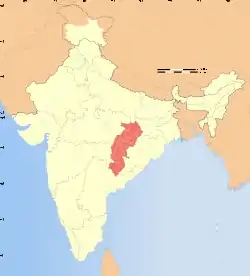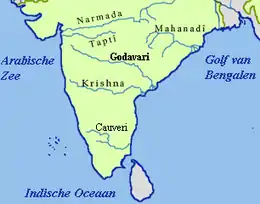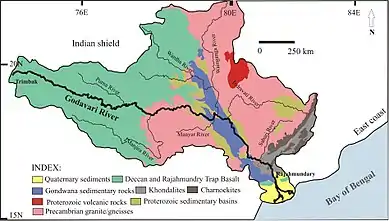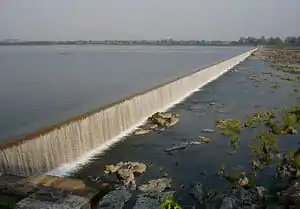Bijapur district, Chhattisgarh
Bijapur District, formerly known as Birjapur, is one of the 27[1] districts of the state of Chhattisgarh in central India. It is one of the two new districts created on May 11, 2007. As of 2011 it is the second least populous district of Chhattisgarh (out of 18), after Narayanpur. It is the second-least literate district in India, with a literacy rate of at 41.58%, according to the 2011 census.[2]
Bijapur district | |
|---|---|
District of Chhattisgarh | |
.svg.png.webp) Location of Bijapur district in Chhattisgarh | |
| Country | |
| State | Chhattisgarh |
| Division | Bastar |
| Headquarters | Bijapur |
| Tehsils | 4 |
| Area | |
| • Total | 6,562.48 km2 (2,533.79 sq mi) |
| Population (2011) | |
| • Total | 255,230 |
| • Density | 39/km2 (100/sq mi) |
| Demographics | |
| • Literacy | 41.58% |
| • Sex ratio | 982 |
| Time zone | UTC+05:30 (IST) |
| Major highways | NH-16 |
| Average annual precipitation | 1517 mm |
| Website | bijapur |
The present collector of Bijapur is Shri Ritesh Agrawal (IAS).[3]
History
Bijapur district was formerly part of the Dantewada district. It is currently a part of the Red Corridor of Naxalite activity.[4]
Geography
The Bijapur district occupies the south western part of Chhattisgarh. The district borders on the Narayanpur district to the north and the Dantewada district to the east. To the southwest, it borders on Telangana state, to the west on Maharashtra state. Chhattisgarh Highest Waterfall Nambi Jaldhara about 540 feet (earlier was Teerathgarh Waterfall in Dantevada about 300 feet) Founded Near Usur, 64 km away from Bijapur.
Indravati River, a key geographical feature of the district, flows across the southern part of the district. The highest hill is Bailadila or the "Bullock's Hump". It is situated to the south of the Indravati River and tilts towards north-south.
This district occupies an area of 6555 km². Bijapur is the administrative headquarters.[5] In total, the district comprises 675 villages.[6]
Transport
The nearest airport is at Raipur.
Railway
There is no railway station in this district as the district is situated in the western side of Bailadila Range. Railway connectivity is available to the eastern side of Bailadila Range. Nearby railway station is Dantewada, which is 92 KM west of district headquarter. The track belongs to East Coast Railway zone which further connects to Jagdalpur , Jeypore and Koraput Junction .
Road
The National Highway that passes Bijapur town is the NH16. It connects Bijapur to Jagdalpur towards the east and to Nizamabad in Andhra Pradesh in the west while passing through Maharashtra.
The NH 63 at Bhopalpatnam connects Bijapur to the NH 202 leading to Warangal and Hyderabad.
Bijapur and Jagdalpur towns connects to Nizamabad in Telangana while passing through Maharashtra. A Bridge which has been made and started across the river and the ferry system which was a trouble has been solved. The indravati bridge now operates 24x7 in all weather connecting the district to States of Maharashtra and Telangana .
Also other bridge as one goes further towards Maharashtra on the NH 16, there was another bridge missing on river Pranahita near Sironcha was also inaugurated and has been helping to cross the river while connecting the road network of the area.[7]
Flora and fauna
The district is rich in forest. The forest found in the district falls under the dry region comprising mixed forest range. The dry region consists of mixed forest is extensive and is interspersed between the moist and intermediate belt but more generally confined to the western half and southern parts of the district. A variety of trees are found for example, Dhawra (Anogeissus latifolia), Bhirra (Chloroxylon swietenia), Rhoni (Soymida febrifuga) and others like Char, Tendu, Aonia, Aonla, Harra and Haria.
In the rocky regions, the trees are generally stunted and deformed. Common trees in the rocky region are Salai, Hangu, Khair, Harra, Palas and Sesam. In the northern portions of the district, the forest trees are Teak (Tectona grandis), Sal (Shoraaro-busta), Sirsa (Dalbergia latifolia), Bijasal (Ptetocarpus marsupium), Kusum (Schleichera trijuga), Palas (Butea frondosa), Mahua (Bassia latifolia) Tendu (Diospyos melanoxylon), Harra (Terminalia chebula) Aonla (Phyllanthus emblica) Saja (Terminalla tomentosa), Kauha (T. arjuna), Salai (Boswellia serrata), Char (Buchanania latifolia) amongst others.
Palms fill an important place in the domestic economy of the people. The Palmyra palm (Borassua flabellifer), locally known as tar, grows extensively in the south-west. From this people extract tari. Also of importance is Sulphy (Caryota urens). Sulphy grows in the shady valleys of hills and depressions of undulating plains. It thrives best in the central regions of the district. The sulphi yields a sap, known by the same name, and provides a delicious juice. Other palm trees are the wild date palms (Phoenix Sylvestris) and P. acaulis, which are locally named as chhind and the buta chhind (P. farinifera). From the stem of this buta chhind is obtained a grub which is a delicacy for the tribes.
The district is famous for its rich wildlife as it has very thick cover of forest. Tigers and panthers are found throughout the district in the forest.
Demographics
According to the 2011 census Bijapur district, Chhattisgarh has a population of 255,230,[8] roughly equal to the nation of Vanuatu.[9] This gives it a ranking of 581st in India (out of a total of 640).[8] The district has a population density of 39 inhabitants per square kilometre (100/sq mi).[8] Its population growth rate over the decade 2001-2011 was 8.76%.[8] Bijapur has a sex ratio of 982 females for every 1000 males,[8] and a literacy rate of 41.58%.[8]
At the time of the 2011 Census of India, 62.79% of the population in the district spoke Gondi, 17.30% Telugu, 7.76% Halbi, 7.00% Chhattisgarhi and 3.59% Marathi as their first language.[10]
References
- "Chhattisgarh carves out nine more districts". The Times Of India. 2012-01-01.
- "Bijapur District Census 2011". Census2011.co.in. 2011. Retrieved 2011-10-11.
- http://bijapur.gov.in
- "83 districts under the Security Related Expenditure Scheme". IntelliBriefs. 2009-12-11. Retrieved 2011-09-17.
- Srivastava, Dayawanti et al (ed.) (2010). India 2010, A Reference Annual (PDF). New Delhi: Publications Division, Ministry of Information and Broadcasting, Government of Indiaand. p. 1122. ISBN 978-81-230-1617-7. Archived from the original (PDF) on 2010-12-29. Retrieved 2011-01-21.CS1 maint: extra text: authors list (link)
- "2 new districts formed in Chhattisgarh". April 20, 2010.
- Panigrahi, Debashish (2009-09-30). "Life at the end of the road". Hindustan Times. Retrieved 2020-12-24.
- "District Census 2011". Census2011.co.in. 2011. Retrieved 2011-09-30.
- US Directorate of Intelligence. "Country Comparison:Population". Retrieved 2011-10-01.
Vanuatu 224,564 July 2011 est.
- 2011 Census of India, Population By Mother Tongue




